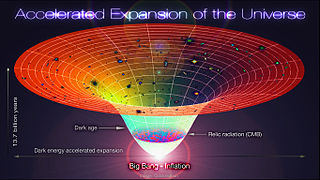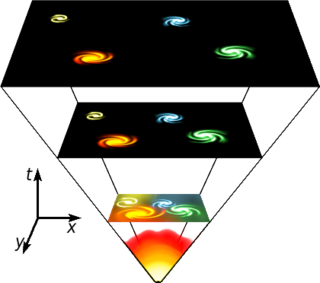Related Research Articles

Falsifiability is a deductive standard of evaluation of scientific theories and hypotheses, introduced by the philosopher of science Karl Popper in his book The Logic of Scientific Discovery (1934). A theory or hypothesis is falsifiable if it can be logically contradicted by an empirical test.

The multiverse is the hypothetical set of all universes. Together, these universes are presumed to comprise everything that exists: the entirety of space, time, matter, energy, information, and the physical laws and constants that describe them. The different universes within the multiverse are called "parallel universes", "flat universes", "other universes", "alternate universes", "multiple universes", "plane universes", "parent and child universes", "many universes", or "many worlds". One common assumption is that the multiverse is a "patchwork quilt of separate universes all bound by the same laws of physics."
In philosophy, Occam's razor is the problem-solving principle that recommends searching for explanations constructed with the smallest possible set of elements. It is also known as the principle of parsimony or the law of parsimony. Attributed to William of Ockham, a 14th-century English philosopher and theologian, it is frequently cited as Entia non sunt multiplicanda praeter necessitatem, which translates as "Entities must not be multiplied beyond necessity", although Occam never used these exact words. Popularly, the principle is sometimes paraphrased as "The simplest explanation is usually the best one."

In cosmology, the cosmological constant, alternatively called Einstein's cosmological constant, is the constant coefficient of a term that Albert Einstein temporarily added to his field equations of general relativity. He later removed it, however much later it was revived and reinterpreted as the energy density of space, or vacuum energy, that arises in quantum mechanics. It is closely associated with the concept of dark energy.

Observations show that the expansion of the universe is accelerating, such that the velocity at which a distant galaxy recedes from the observer is continuously increasing with time. The accelerated expansion of the universe was discovered in 1998 by two independent projects, the Supernova Cosmology Project and the High-Z Supernova Search Team, which used distant type Ia supernovae to measure the acceleration. The idea was that as type Ia supernovae have almost the same intrinsic brightness, and since objects that are farther away appear dimmer, the observed brightness of these supernovae can be used to measure the distance to them. The distance can then be compared to the supernovae's cosmological redshift, which measures how much the universe has expanded since the supernova occurred; the Hubble law established that the farther away that an object is, the faster it is receding. The unexpected result was that objects in the universe are moving away from one another at an accelerating rate. Cosmologists at the time expected that recession velocity would always be decelerating, due to the gravitational attraction of the matter in the universe. Three members of these two groups have subsequently been awarded Nobel Prizes for their discovery. Confirmatory evidence has been found in baryon acoustic oscillations, and in analyses of the clustering of galaxies.
Ad hoc is a Latin phrase meaning literally 'for this'. In English, it typically signifies a solution for a specific purpose, problem, or task rather than a generalized solution adaptable to collateral instances.
The ultimate fate of the universe is a topic in physical cosmology, whose theoretical restrictions allow possible scenarios for the evolution and ultimate fate of the universe to be described and evaluated. Based on available observational evidence, deciding the fate and evolution of the universe has become a valid cosmological question, being beyond the mostly untestable constraints of mythological or theological beliefs. Several possible futures have been predicted by different scientific hypotheses, including that the universe might have existed for a finite and infinite duration, or towards explaining the manner and circumstances of its beginning.
A scientific theory is an explanation of an aspect of the natural world and universe that can be repeatedly tested and corroborated in accordance with the scientific method, using accepted protocols of observation, measurement, and evaluation of results. Where possible, some theories are tested under controlled conditions in an experiment. In circumstances not amenable to experimental testing, theories are evaluated through principles of abductive reasoning. Established scientific theories have withstood rigorous scrutiny and embody scientific knowledge.

The Big Crunch is a hypothetical scenario for the ultimate fate of the universe, in which the expansion of the universe eventually reverses and the universe recollapses, ultimately causing the cosmic scale factor to reach zero, an event potentially followed by a reformation of the universe starting with another Big Bang. The vast majority of evidence indicates that this hypothesis is not correct. Instead, astronomical observations show that the expansion of the universe is accelerating rather than being slowed by gravity, suggesting that a Big Chill is more likely. However, some physicists have proposed that a "Big Crunch-style" event could result from a dark energy fluctuation.
A non-standard cosmology is any physical cosmological model of the universe that was, or still is, proposed as an alternative to the then-current standard model of cosmology. The term non-standard is applied to any theory that does not conform to the scientific consensus. Because the term depends on the prevailing consensus, the meaning of the term changes over time. For example, hot dark matter would not have been considered non-standard in 1990, but would have been in 2010. Conversely, a non-zero cosmological constant resulting in an accelerating universe would have been considered non-standard in 1990, but is part of the standard cosmology in 2010.
The hypothetico-deductive model or method is a proposed description of the scientific method. According to it, scientific inquiry proceeds by formulating a hypothesis in a form that can be falsifiable, using a test on observable data where the outcome is not yet known. A test outcome that could have and does run contrary to predictions of the hypothesis is taken as a falsification of the hypothesis. A test outcome that could have, but does not run contrary to the hypothesis corroborates the theory. It is then proposed to compare the explanatory value of competing hypotheses by testing how stringently they are corroborated by their predictions.
The characterization of the universe as finely tuned intends to explain why the known constants of nature, such as the electron charge, the gravitational constant, and the like, have their measured values rather than some other arbitrary values. According to the "fine-tuned universe" hypothesis, if these constants' values were too different from what they are, "life as we know it" could not exist. In practice, this hypothesis is formulated in terms of dimensionless physical constants.
Tired light is a class of hypothetical redshift mechanisms that was proposed as an alternative explanation for the redshift-distance relationship. These models have been proposed as alternatives to the models that involve the expansion of the universe. The concept was first proposed in 1929 by Fritz Zwicky, who suggested that if photons lost energy over time through collisions with other particles in a regular way, the more distant objects would appear redder than more nearby ones.
A fudge factor is an ad hoc quantity or element introduced into a calculation, formula or model in order to make it fit observations or expectations. Also known as a correction coefficient, which is defined by
General relativity is a theory of gravitation that was developed by Albert Einstein between 1907 and 1915, with contributions by many others after 1915. According to general relativity, the observed gravitational attraction between masses results from the warping of space and time by those masses.

The history of the Big Bang theory began with the Big Bang's development from observations and theoretical considerations. Much of the theoretical work in cosmology now involves extensions and refinements to the basic Big Bang model. The theory itself was originally formalised by Father Georges Lemaître in 1927. Hubble's Law of the expansion of the universe provided foundational support for the theory.
In cosmology, a static universe is a cosmological model in which the universe is both spatially and temporally infinite, and space is neither expanding nor contracting. Such a universe does not have so-called spatial curvature; that is to say that it is 'flat' or Euclidean. A static infinite universe was first proposed by English astronomer Thomas Digges (1546–1595).
An inhomogeneous cosmology is a physical cosmological theory which, unlike the currently widely accepted cosmological concordance model, assumes that inhomogeneities in the distribution of matter across the universe affect local gravitational forces enough to skew our view of the Universe. When the universe began, matter was distributed homogeneously, but over billions of years, galaxies, clusters of galaxies, and superclusters have coalesced, and must, according to Einstein's theory of general relativity, warp the space-time around them. While the concordance model acknowledges this fact, it assumes that such inhomogeneities are not sufficient to affect large-scale averages of gravity in our observations. When two separate studies claimed in 1998-1999 that high redshift supernovae were further away than our calculations showed they should be, it was suggested that the expansion of the universe is accelerating, and dark energy, a repulsive energy inherent in space, was proposed to explain the acceleration. Dark energy has since become widely accepted, but it remains unexplained. Accordingly, some scientists continue to work on models that might not require dark energy. Inhomogeneous cosmology falls into this class.
In physical cosmology and astronomy, dark energy is an unknown form of energy that affects the universe on the largest scales. Its primary effect is to drive the accelerating expansion of the universe. Assuming that the lambda-CDM model of cosmology is correct, dark energy is the dominant component of the universe, contributing 68% of the total energy in the present-day observable universe while dark matter and ordinary (baryonic) matter contribute 26% and 5%, respectively, and other components such as neutrinos and photons are nearly negligible. Dark energy's density is very low: 7×10−30 g/cm3, much less than the density of ordinary matter or dark matter within galaxies. However, it dominates the universe's mass–energy content because it is uniform across space.
The zero-energy universe hypothesis proposes that the total amount of energy in the universe is exactly zero: its amount of positive energy in the form of matter is exactly canceled out by its negative energy in the form of gravity. Some physicists, such as Lawrence Krauss, Stephen Hawking or Alexander Vilenkin, call or called this state "a universe from nothingness", although the zero-energy universe model requires both a matter field with positive energy and a gravitational field with negative energy to exist. The hypothesis is broadly discussed in popular sources. Other cancellation examples include the expected symmetric prevalence of right- and left-handed angular momenta of objects, the observed flatness of the universe, the equal prevalence of positive and negative charges, opposing particle spin in quantum mechanics, as well as the crests and troughs of electromagnetic waves, among other possible examples in nature.
References
- 1 2 Stanovich, Keith E. (2007). How to Think Straight About Psychology. Boston: Pearson Education. Pages 19-33
- ↑ Carroll, Robert T. "Ad hoc hypothesis." The Skeptic's Dictionary. 22 Jun. 2008 <http://skepdic.com/adhoc.html>.
- ↑ Texas A&M University. "Einstein's Biggest Blunder? Dark Energy May Be Consistent With Cosmological Constant." ScienceDaily 28 November 2007. 22 June 2008 <https://www.sciencedaily.com/releases/2007/11/071127142128.htm>.